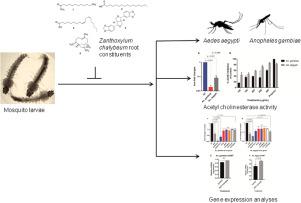Pesticide Biochemistry and Physiology ( IF 4.2 ) Pub Date : 2021-06-30 , DOI: 10.1016/j.pestbp.2021.104912 Jackson M Muema 1 , Joel L Bargul 2 , James M Mutunga 3 , Meshack A Obonyo 4 , George O Asudi 5 , Sospeter N Njeru 6

|
Intracellular effects exerted by phytochemicals eliciting insect growth-retarding responses during vector control intervention remain largely underexplored. We studied the effects of Zanthoxylum chalybeum Engl. (Rutaceae) (ZCE) root derivatives against malaria (Anopheles gambiae) and arbovirus vector (Aedes aegypti) larvae to decipher possible molecular targets. We report dose-dependent biphasic effects on larval response, with transient exposure to ZCE and its bioactive fraction (ZCFr.5) inhibiting acetylcholinesterase (AChE) activity, inducing larval lethality and growth retardation at sublethal doses. Half-maximal lethal concentrations (LC50) for ZCE against An. gambiae and Ae. aegypti larvae after 24-h exposure were 9.00 ppm and 12.26 ppm, respectively. The active fraction ZCFr.5 exerted LC50 of 1.58 ppm and 3.21 ppm for An. gambiae and Ae. aegypti larvae, respectively. Inhibition of AChE was potentially linked to larval toxicity afforded by 2-tridecanone, palmitic acid (hexadecanoic acid), linoleic acid ((Z,Z)-9,12-octadecadienoic acid), sesamin, β-caryophyllene among other compounds identified in the bioactive fraction. In addition, the phenotypic larval retardation induced by ZCE root constituents was exerted through transcriptional modulation of ecdysteroidogenic CYP450 genes. Collectively, these findings provide an explorative avenue for developing potential mosquito control agents from Z. chalybeum root constituents.
中文翻译:

神经毒性花椒根成分通过蜕皮激素 CYP450s 转录扰动引起蚊子幼虫生长迟缓
植物化学物质在病媒控制干预期间引发昆虫生长迟缓反应所产生的细胞内效应在很大程度上仍未得到充分探索。我们研究了Zanthoxylum chalybeum Engl 的作用。(芸香科)(ZCE)根衍生物对抗疟疾(冈比亚按蚊)和虫媒病毒载体(埃及伊蚊)幼虫,以破译可能的分子靶标。我们报告了对幼虫反应的剂量依赖性双相效应,瞬时暴露于 ZCE 及其生物活性部分 (ZCFr.5) 抑制乙酰胆碱酯酶 (AChE) 活性,在亚致死剂量下诱导幼虫致死和生长迟缓。ZCE 对An 的半数最大致死浓度 (LC 50 ) 。冈比亚和Ae。埃及暴露 24 小时后的幼虫分别为 9.00 ppm 和 12.26 ppm。活性组分 ZCFr.5 的 LC 50为 1.58 ppm,而An为 3.21 ppm 。冈比亚和Ae。aegypti幼虫,分别。AChE 的抑制作用可能与 2-十三烷酮、棕榈酸(十六烷酸)、亚油酸(( Z,Z )-9,12-十八碳二烯酸)、芝麻素、β-石竹烯等其他化合物提供的幼虫毒性有关。生物活性部分。此外,由 ZCE 根成分诱导的表型幼虫发育迟缓是通过蜕皮甾体生成 CYP450 基因的转录调节发挥的。总的来说,这些发现为开发潜在的蚊子控制剂提供了探索性的途径。Z. chalybeum根成分。











































 京公网安备 11010802027423号
京公网安备 11010802027423号